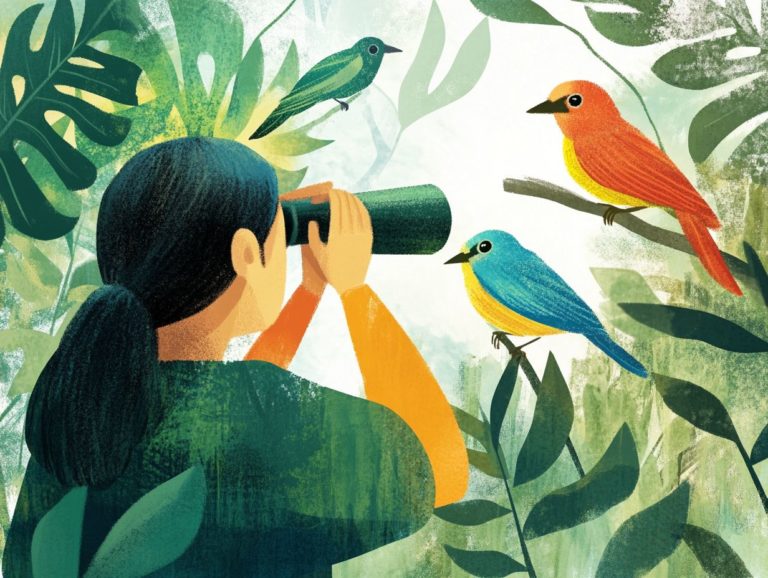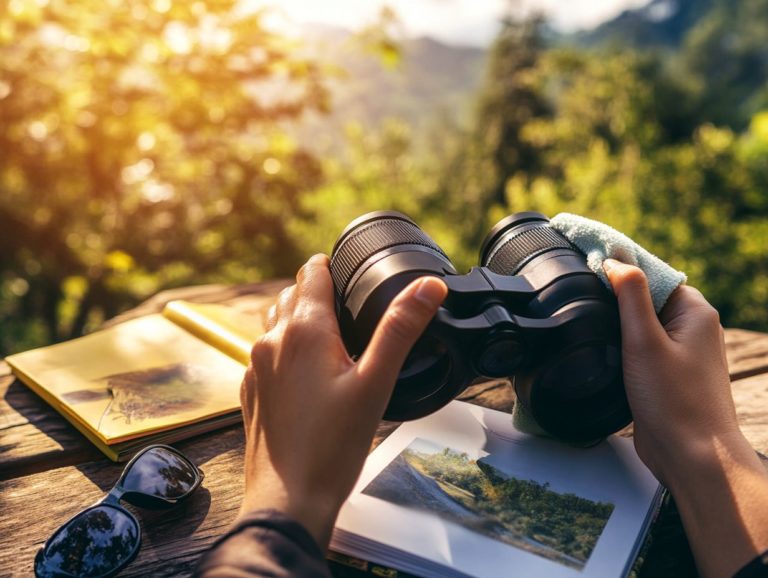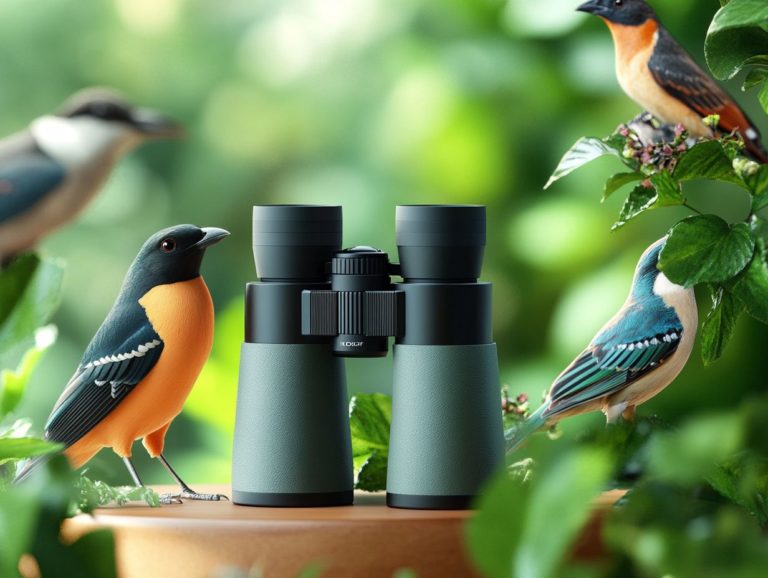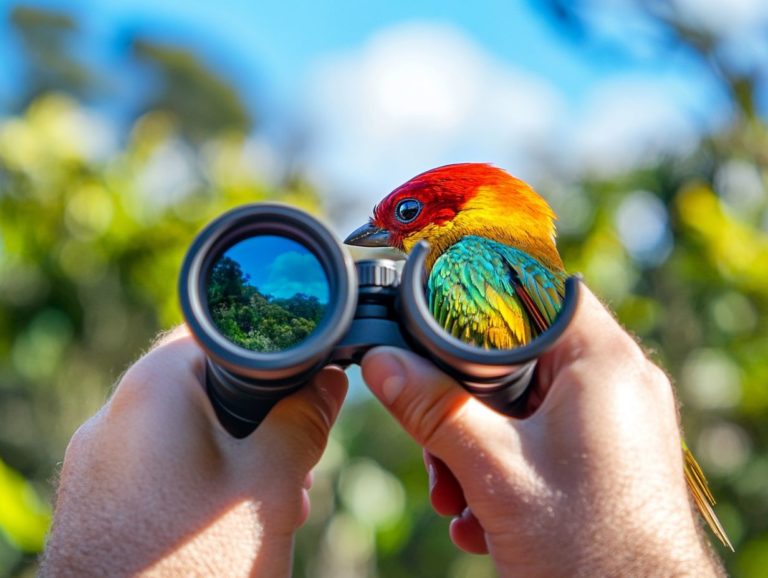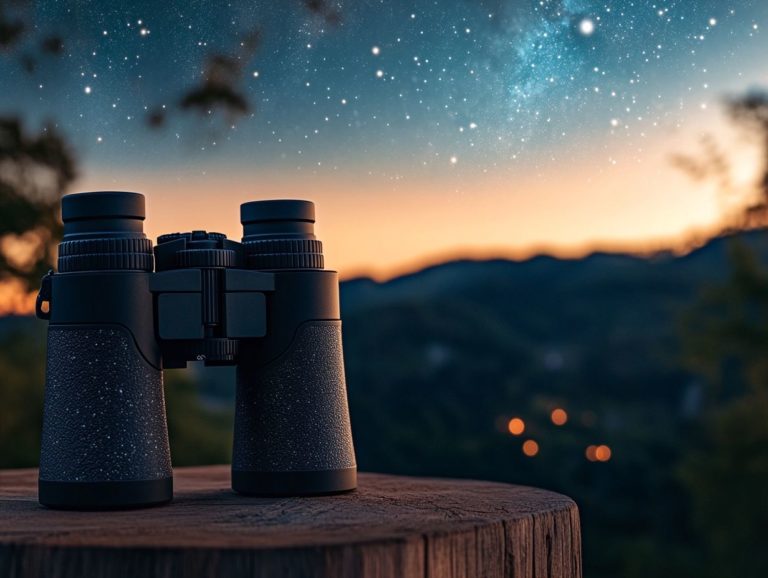Choosing Binoculars for Different Bird Species
Birdwatching is a truly rewarding hobby that connects you to the beauty of nature. Having the right pair of binoculars can significantly enhance your experience!
This guide breaks down the essentials of birding binoculars, highlighting key features and functions that elevate your observations. You will discover how to select the perfect binoculars by considering factors such as magnification, comfort, and durability.
You will explore the best options for various bird species and receive valuable tips on using and maintaining your gear. Whether you re just starting out or you ve been birdwatching for years, this information will empower you to elevate your birding adventures to new heights and increase your viewing success!
Contents
- Key Takeaways:
- Understanding Birding Binoculars
- Factors to Consider When Choosing Binoculars for Birding
- Best Binoculars for Different Bird Species
- Get Ready to Enhance Your Birdwatching Adventure with These Essential Binocular Tips!
- Frequently Asked Questions
- What should I consider when choosing binoculars for different bird species?
- What magnification power is best for bird watching?
- Do I need waterproof binoculars for bird watching?
- How does the field of view impact bird watching?
- Should I choose binoculars with a smaller or larger lens size for bird watching?
- Can I use the same binoculars for all bird species?
Key Takeaways:
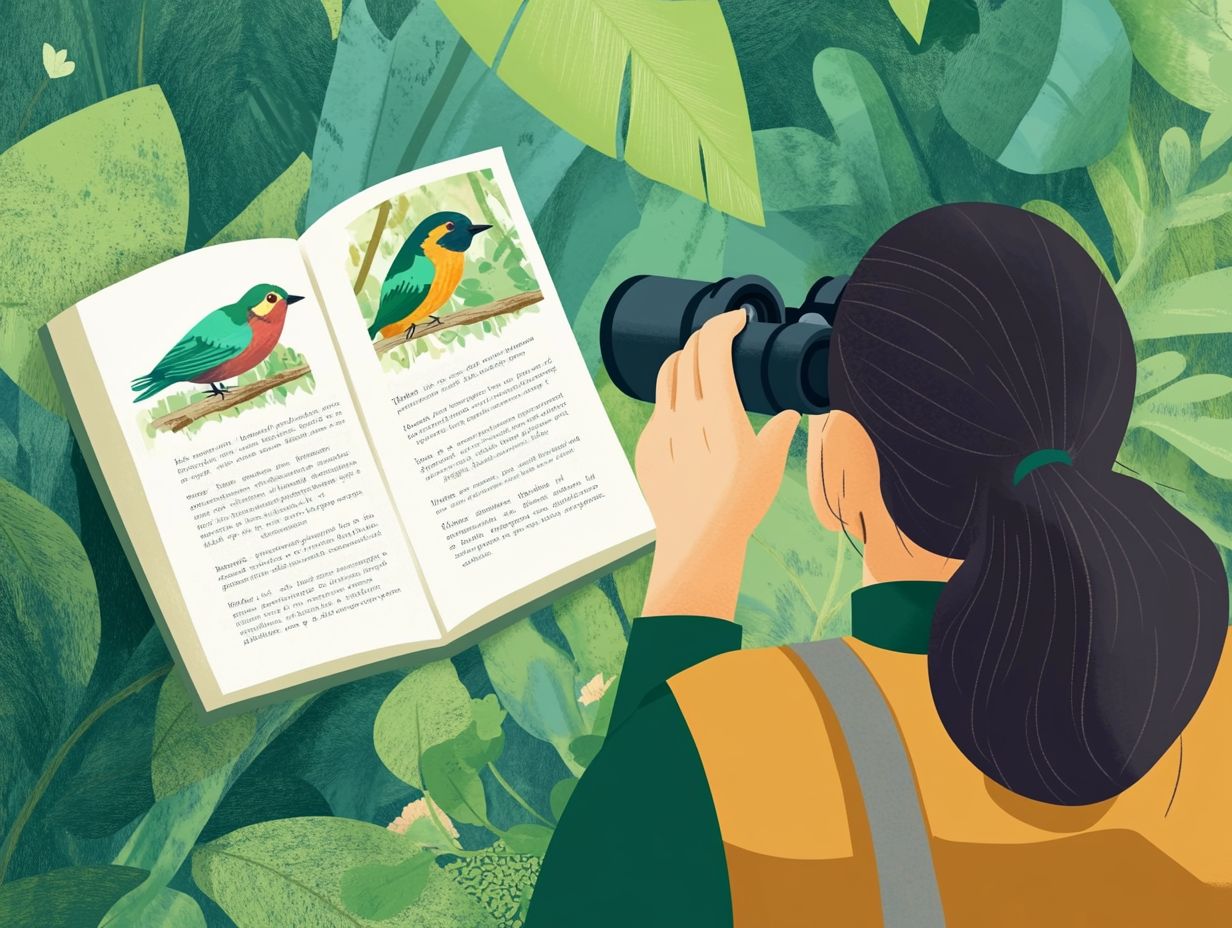
- Consider magnification and lens size when choosing binoculars to ensure a clear and detailed view of different bird species.
- Choose lightweight and comfortable binoculars to prevent fatigue and strain while birding in the field.
- Look for binoculars that are waterproof to ensure clear vision even in wet conditions.
Understanding Birding Binoculars
Understanding birding binoculars is key to enhancing your observation experience in natural habitats. These specialized tools not only magnify distant subjects but also come in various configurations. Knowing what to look for when buying birding binoculars can help you meet your specific birding needs.
When choosing binoculars, consider factors like clear vision, magnification, and field of view to ensure you have the best possible birdwatching experience. Organizations such as the US Fish and Wildlife Service and the Audubon Society stress the importance of using these optics responsibly to promote bird conservation. To enhance your adventures, learn how to select binoculars for bird watching tours.
Retailers like B&H Photo offer a wide range of birding optics to help you connect deeper with nature.
Key Features and Functions
Key features and functions of binoculars play a pivotal role in enhancing your birding experience, especially when observing various species in their natural habitats. High optical quality ensures that you can view subjects with remarkable clarity, while specifications like objective diameter and magnification power are essential for different observation scenarios.
Close focus capabilities enable you to examine small birds in detail, making these features essential for effective birding optics. Options like zoom binoculars offer versatility for viewing distant subjects, catering to the diverse needs of bird watchers.
Understanding the significance of each feature can significantly elevate your birdwatching experience. For example, higher magnification power allows you to spot elusive species perched high in trees, but it often comes at the expense of a narrower field of view, making it challenging to track fast-moving birds.
Finding the right balance between magnification and field of view is essential. Features like anti-reflective coatings enhance light transmission, providing clearer views during those magical early mornings or late evenings when birds are most active.
Durability and weather resistance are also essential, as birdwatching often involves unpredictable outdoor conditions. The right set of binoculars not only facilitates exceptional visual clarity and versatility but also ensures that you can engage with nature seamlessly and without interruption.
Factors to Consider When Choosing Binoculars for Birding
When selecting binoculars for birding, several key factors significantly influence your observation experience. Understanding how to choose binoculars for bird watching is essential, as the right magnification and lens size determine how well you can spot distant birds.
Don’t forget about the weight and comfort of the binoculars; these are critical, especially during those long birdwatching sessions across varied terrains.
Features such as waterproof and fog-proof designs enhance both durability and usability, allowing you to depend on your optics even in unpredictable weather.
Familiarizing yourself with the different binocular configurations will empower you to make an informed choice that perfectly fits your birding needs. Get ready to dive into birdwatching with the best binoculars!
Magnification and Lens Size
When you re selecting binoculars for birding, magnification and lens size are critical considerations that can significantly impact your experience. The magnification power, often expressed as a ratio like 8×42, tells you how much closer a bird will appear. The front lens size determines how much light is gathered, enhancing clarity and visibility.
You might find yourself debating power; higher magnification can certainly make distant birds appear closer, but it also narrows your field of view, making it trickier to track those elusive, moving targets. Understanding this relationship is essential for optimizing your optics in diverse environments.
For example, if you re quietly observing a perched hawk from afar, a pair with higher magnification, like 10×42, can help you appreciate the exquisite details of its plumage. On the flip side, if you’re in dense woods where fast-moving songbirds flit about, a lower magnification of 7×35 will give you a wider field of view, making it easier to follow their quick, darting movements.
Don’t overlook lens size; a larger lens allows more light in, especially during those fleeting, magical dawn or dusk moments when many species are most active. By following tips for choosing binoculars for bird photography that match the configuration of your binoculars to your specific birdwatching conditions, you can elevate your overall experience and increase your chances of spotting a variety of species.
Weight and Comfort

The weight and comfort of binoculars matter immensely for you as a birder spending extended periods observing birds in their natural habitats. Opting for lightweight binoculars makes transport a breeze and allows for longer use without fatigue, making them perfect for your outdoor adventures.
Comfort features like ergonomic designs and adjustable eyecups significantly enhance your experience, letting you focus on your observations without distractions. It s crucial for you to strike a balance between durable construction and manageable weight, so you can fully enjoy observing different species without discomfort.
When selecting your binoculars, consider models with rubberized grips for better handling, especially during those long excursions. Most seasoned birders recommend testing the binoculars for comfort by holding them for a few minutes to see how they feel in your hands and around your eyes.
Features like twist-up eyecups cater to various eye relief needs, ensuring both eyeglass wearers and non-wearers find them comfortable for extended birding sessions. Ultimately, investing your time in testing various options can lead you to discover a pair that feels just right and enhances your birdwatching experience, allowing for long, enjoyable hours in the field.
Waterproof and Fog-proof Features
Waterproof and fog-proof features in binoculars are essential for you as a birder who navigates diverse weather conditions during your birdwatching excursions. These features enhance the durability of the optics and ensure clear visibility in variable environments, preventing fogging and moisture from interrupting your observation experience.
By investing in high-quality birding optics that are waterproof and fog-proof, you can dive into exciting birdwatching adventures without worry! Imagine encountering sudden rain or dealing with heavy dew at dawn while you re immersed in nature. In such moments, having binoculars designed to withstand these conditions allows you to continue observing your feathered friends without missing a beat.
The fog-proof capability becomes invaluable during those early morning outings when temperature fluctuations threaten to lead to condensation. Manufacturers rigorously test these features by subjecting the optics to intense pressure and water immersion tests, often rating them based on industry standards like the IPX rating system.
This gives you the assurance that your equipment is built to last under duress, making your birdwatching experiences not only reliable but truly enjoyable. So gear up and get ready to spot your favorite birds with the perfect binoculars!
Best Binoculars for Different Bird Species
Choosing the right binoculars for various bird species is essential to enhancing your birding experience. For more insight, consider comparing different types of binoculars for birding, as each type of bird brings its own set of observation challenges and requirements.
For small birds, opt for compact binoculars with impressive close focus capabilities. To learn more about choosing the right ones, check out this guide on how to pick binoculars for birding tours. This allows you to capture the fine details in their plumage.
For larger birds, you will want binoculars with higher magnification to truly appreciate their size and behaviors from afar.
If you are keen on spotting water birds, waterproof binoculars are a must. They let you observe these creatures in their natural wetland habitats.
Understanding the specific needs for each group of birds will elevate your birdwatching game to new heights.
Binoculars for Small Birds
When observing small birds, it is essential to choose binoculars with exceptional close focus capabilities and a lightweight design. For more insights on this, consider using binoculars effectively for bird identification. These features enable you to appreciate the intricate details and behaviors of tiny avian species without the burden of cumbersome equipment.
As you select the perfect pair, look for models that offer a close focus distance of under six feet. This can be particularly advantageous for watching hummingbirds and other petite species as they feed or interact in their natural habitats.
You will likely find that lightweight constructions, ideally weighing under 20 ounces, make your adventures much more enjoyable, especially on long hikes or spontaneous trips to local parks.
Don t miss out on popular options like the Nikon Monarch or Zeiss Terra. They are well-regarded for their optical excellence and user-friendly designs, making them favorites among birders.
With their impressive color fidelity and brightness, these binoculars enhance your viewing experience, allowing you to revel in the beautiful subtleties of plumage and behavior displayed by small birds.
Binoculars for Large Birds
When observing large birds, choosing the right binoculars with the proper magnification and viewing distance is essential for elevating your birding experience. To learn more about this, check out our guide on understanding binocular specifications for birders.
The right pair transforms your moments spent watching these magnificent creatures as they soar gracefully through the sky or perch elegantly on branches.
Models like 8×42 or 10×42 offer an ideal balance between detail and a wide field of view. This enables you to spot and follow their movements with ease. A broader field of view helps you track fast-flying birds and amplifies your awareness of their surroundings.
Consider exceptional options such as the Nikon Monarch 5 or the Vortex Viper HD. These choices blend high-quality optics with ergonomic design, ensuring enjoyable lengthy birdwatching sessions.
By grasping the relationship between magnification and field of view, you can fully immerse yourself in the enchanting world of large avian species.
Binoculars for Water Birds

For the avid birder with a keen interest in water birds, selecting binoculars that are both waterproof and fog-proof is essential. These features ensure crystal-clear visibility in the often humid and wet environments where these birds thrive.
With moisture protection for the optics, you can observe waterfowl and shorebirds without compromising the clarity of your views.
Opting for binoculars with a wider field of view enhances your tracking abilities, making it easier to spot and appreciate the unique behaviors of these magnificent creatures.
Choosing the right birding optics significantly elevates your experience of observing aquatic species.
Look for options that include rubber armor. They provide an extra grip and durability, perfect for handling in slippery conditions.
Many birders prefer configurations that boast high magnification paired with a large objective lens. This combination maximizes light transmission, ensuring you enjoy vivid and detailed images, even during early morning or late evening excursions.
Don t miss out on models like the Swarovski EL Companion or the Canon 10x42L. They offer exceptional clarity and brightness, ideal for spotting distant herons or stealthy egrets.
By investing in quality binoculars designed specifically for the unique challenges of water birdwatching, you can truly immerse yourself in the diverse world of avian life along shorelines and wetlands.
Get Ready to Enhance Your Birdwatching Adventure with These Essential Binocular Tips!
To truly elevate your birdwatching experience, mastering effective binocular techniques and committing to regular maintenance is essential. Understanding the right grip and positioning enhances your stability and significantly improves viewing quality, allowing for sharp, focused views of your feathered friends.
Don t forget about routine maintenance. Cleaning the lenses and ensuring those waterproof seals are intact are crucial steps in preserving viewing quality over time. By incorporating these practices, you’ll unlock a more rewarding and enjoyable birdwatching journey.
Proper Technique and Maintenance
Mastering the proper technique and maintenance of your binoculars is vital for any birder looking to elevate their observation skills while ensuring the longevity of their optics. By using correct techniques like steadying the binoculars against your face and using both hands for stability you can dramatically reduce image shake and enhance focus.
Regular maintenance, such as lens cleaning and checking for waterproof integrity, keeps your binoculars in peak condition, enabling you to fully embrace your birdwatching adventures. Understanding and applying these techniques can truly elevate your overall birding experience.
Stabilizing your grip is crucial. Using a neck strap or harness can be a game changer, preventing accidental drops and providing extra support during extended viewing sessions.
When it’s time to adjust focus, make sure you utilize the right focus adjustment to compensate for any differences in your vision, allowing for a clearer view of those distant birds.
Keep your lenses pristine by regularly cleaning them with a soft microfiber cloth and storing them in a protective case to fend off dust and scratches. Periodically check seals and joints for any signs of wear to ensure your optics perform at their best, no matter what the environment throws your way.
Frequently Asked Questions
Here are some common questions about choosing the right binoculars for birdwatching.
What should I consider when choosing binoculars for different bird species?
When choosing binoculars for different bird species, consider the magnification power, field of view, and lens size. For more guidance, refer to our article on how to choose binoculars for long-distance birding. These factors impact your ability to see birds clearly and in detail.
What magnification power is best for bird watching?

Most bird watchers recommend binoculars with a magnification power between 7x and 10x. This range allows you to see birds in detail without sacrificing a wide field of view.
Do I need waterproof binoculars for bird watching?
It’s not necessary to have waterproof binoculars for bird watching. However, if you plan on birdwatching in wet or humid environments, waterproof binoculars provide added protection against moisture damage.
How does the field of view impact bird watching?
The field of view is the area visible through binoculars. A wider field of view allows you to spot birds more easily and track them as they move, making it preferred for birdwatching.
Should I choose binoculars with a smaller or larger lens size for bird watching?
For bird watching, a larger lens size is generally recommended. This allows more light to enter the binoculars, resulting in brighter and clearer images of birds. However, a larger lens size also means the binoculars will be heavier.
Can I use the same binoculars for all bird species?
While you can use the same binoculars for different bird species, it may not provide the best experience. Each species has unique characteristics that may require specific features in binoculars, such as close focus ability or high magnification power. To enhance your bird watching experience, consider choosing the right binoculars tailored to your needs.
Start using these techniques today and see the difference in your birdwatching experience!


